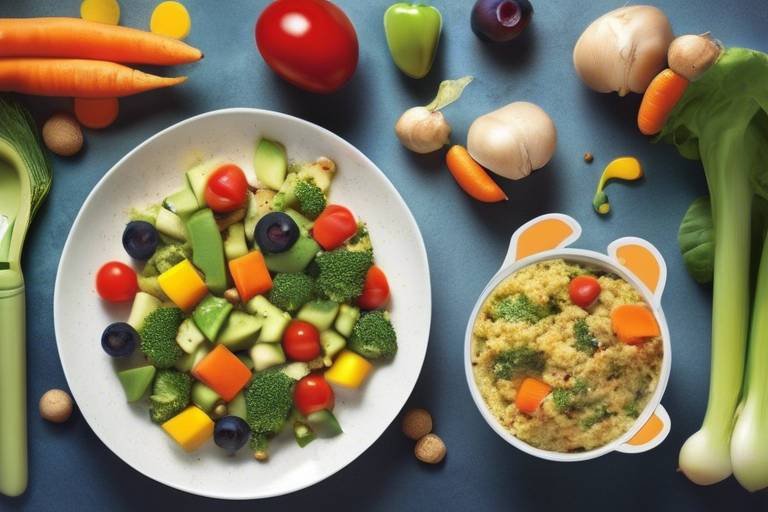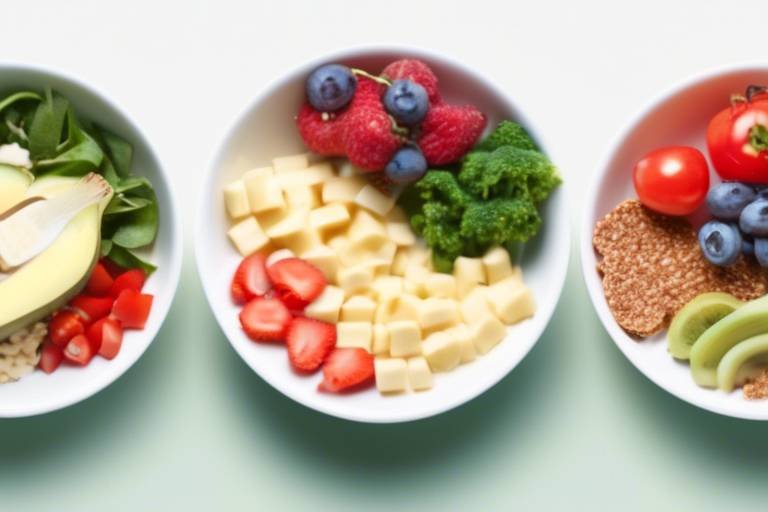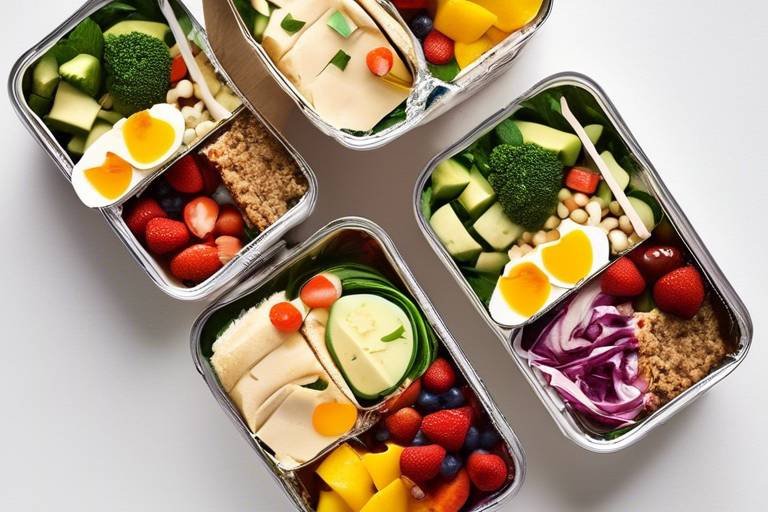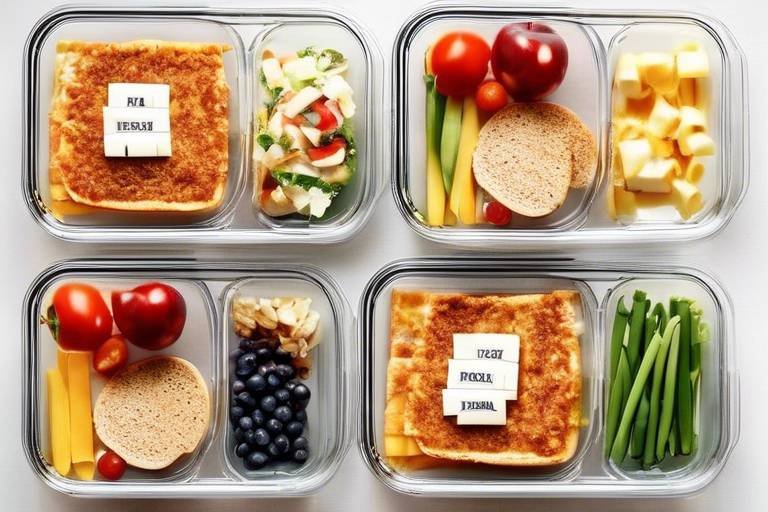10 Superfoods to Include in Your Family's Weekly Meal Plan
In today's fast-paced world, ensuring that your family eats a balanced diet can often feel like a daunting task. However, incorporating superfoods into your weekly meal plan can simplify this process while providing a plethora of health benefits. Superfoods are nutrient-rich foods that can boost your family's overall health and well-being. This article will explore ten amazing superfoods, each brimming with vitamins, minerals, and antioxidants. We'll not only highlight their health benefits but also provide delicious recipe ideas and tips for seamlessly integrating them into your meals. So, let’s dive into the vibrant world of superfoods that can elevate your family’s diet to new heights!
Quinoa is often hailed as a super grain due to its impressive nutritional profile. Packed with protein, fiber, and essential amino acids, quinoa is a fantastic alternative to traditional grains. To prepare it, simply rinse the seeds, boil them in water, and let them simmer until fluffy. You can use quinoa in various dishes, from salads to stir-fries. A fun twist? Try a quinoa salad with black beans, corn, and lime dressing for a refreshing meal that your family will love!
Often described as a nutritional powerhouse, kale is loaded with vitamins A, C, and K. This leafy green can be enjoyed in salads, smoothies, or even baked into crispy chips. The health benefits are undeniable; kale is known to support heart health and improve digestion. For a family-friendly recipe, consider making a kale and apple salad drizzled with a tangy vinaigrette. It’s a delicious way to get your greens in!
Blueberries are small but mighty, bursting with antioxidants and vitamins that can help fight off diseases. These little fruits are perfect for snacking, but they can also be added to breakfast cereals, yogurt, or smoothies. Did you know that adding a handful of blueberries to your morning oatmeal can enhance both flavor and nutrition? Plus, their vibrant color makes any dish pop!
Salmon is an excellent source of omega-3 fatty acids, which are essential for heart health. Grilling or baking salmon is simple and yields delicious results. Consider a recipe where you marinate salmon in a mixture of soy sauce, honey, and garlic before cooking it to perfection. Serve with a side of steamed broccoli, and you’ll have a meal that’s both nutritious and satisfying!
Sweet potatoes are not only delicious but also a fantastic source of complex carbohydrates and vitamins. They can be roasted, mashed, or even made into fries! Their natural sweetness makes them a hit with kids. Try making sweet potato mash with a hint of cinnamon for a comforting side dish that pairs well with any protein.
Greek yogurt is a creamy delight that’s loaded with protein and probiotics. It’s a versatile ingredient that can be used in both sweet and savory dishes. Use it as a base for smoothies, or mix it with honey and fruit for a healthy dessert. You can even substitute it for sour cream in recipes, adding a nutritious twist to your meals!
Spinach is a leafy green that’s rich in iron and vitamins. It can be easily incorporated into salads, omelets, or pasta dishes. The best part? You can sneak it into smoothies for an extra nutrient boost without altering the taste. A spinach and feta omelet makes for a quick and healthy breakfast that the whole family will enjoy!
Chia seeds may be tiny, but they pack a big punch when it comes to nutrition. They are high in fiber and omega-3 fatty acids. You can sprinkle them on yogurt, mix them into smoothies, or even make chia pudding by soaking them in milk overnight. This makes for a fun, nutritious dessert that your kids will love!
Almonds are a fantastic snack option, rich in healthy fats and protein. They can be eaten raw, roasted, or even blended into almond butter. Incorporating almonds into your family's diet can help with heart health and weight management. Try adding sliced almonds to salads or oatmeal for a satisfying crunch!
Q: How can I encourage my family to try these superfoods?
A: Start by introducing one superfood at a time in familiar dishes. Make it fun by involving your family in the cooking process!
Q: Are superfoods expensive?
A: While some superfoods can be pricey, many are affordable and can be found at local grocery stores. Planning meals around seasonal produce can also help save money.
Q: Can I prepare meals in advance using superfoods?
A: Absolutely! Many superfoods can be cooked in batches and stored for later use, making meal prep a breeze.

1. Quinoa
This article explores ten nutrient-rich superfoods that can enhance your family's diet, providing health benefits, delicious recipes, and tips for incorporating them into your weekly meal planning.
Quinoa, often hailed as a superfood, is not just another trendy grain; it’s a nutritional powerhouse that can elevate your family's meals to a whole new level. Packed with protein, fiber, and essential amino acids, quinoa is a complete protein source, making it an excellent choice for vegetarians and meat-eaters alike. Imagine serving your family a dish that not only fills their bellies but also fuels their bodies with the nutrients they need to thrive!
Preparing quinoa is a breeze! Simply rinse it under cold water to remove its natural coating, called saponin, which can impart a bitter taste. Then, cook it in a pot with water or broth—generally, the ratio is 1 cup of quinoa to 2 cups of liquid. Bring it to a boil, then simmer for about 15 minutes until the grains are fluffy and the water has evaporated. But don’t stop there! Quinoa is incredibly versatile, and you can incorporate it into various dishes. Here are some creative ideas:
- Add it to salads for a protein boost.
- Mix it into soups to make them heartier.
- Use it as a base for stir-fries instead of rice.
- Incorporate it into breakfast bowls with fruits and nuts.
But wait, there’s more! Quinoa isn’t just good for you; it’s also delicious. You can flavor it with herbs and spices, toss in some roasted vegetables, or even make a quinoa salad with a zesty lemon dressing. The nutty flavor complements a variety of ingredients, making it a family favorite. Plus, it cooks up quickly, so you can whip up a healthy meal even on your busiest days.
To help you get started, here’s a simple recipe for a Quinoa Salad that your family will love:
| Ingredients | Quantity |
|---|---|
| Quinoa | 1 cup |
| Cherry tomatoes, halved | 1 cup |
| Cucumber, diced | 1 |
| Feta cheese, crumbled | ½ cup |
| Olive oil | 2 tablespoons |
| Lemon juice | 1 tablespoon |
| Salt and pepper | To taste |
Combine all the ingredients in a large bowl, drizzle with olive oil and lemon juice, and toss to combine. Voila! You have a refreshing and nutritious meal that’s perfect for lunch or dinner. Not only does quinoa provide your family with essential nutrients, but it also encourages them to explore new flavors and textures.
So, why not make quinoa a staple in your weekly meal plan? With its numerous health benefits and culinary flexibility, it’s a decision you and your family won’t regret. Start today, and watch as your meals transform into delicious, healthful experiences that everyone will enjoy!
Q: Is quinoa gluten-free?
A: Yes, quinoa is naturally gluten-free, making it a great alternative for those with gluten sensitivities.
Q: How can I store quinoa?
A: Store uncooked quinoa in an airtight container in a cool, dry place. Cooked quinoa can be refrigerated for up to a week.
Q: Can I eat quinoa every day?
A: Absolutely! Quinoa is nutritious and can be included in your daily meals. Just be sure to balance it with a variety of other foods for a well-rounded diet.

2. Kale
Kale, often hailed as a superfood, is not just another leafy green; it's a nutrient powerhouse that deserves a prominent spot in your family's meal plan. Packed with essential vitamins and minerals, kale is particularly rich in vitamins A, C, and K, along with antioxidants that can help combat oxidative stress in the body. Imagine your body as a car; just like a high-quality fuel keeps your engine running smoothly, incorporating kale into your diet can fuel your body with the nutrients it needs to function at its best.
One of the best things about kale is its versatility. You can toss it into salads, blend it into smoothies, or sauté it as a side dish. Not only does it add a vibrant green color to your plate, but it also brings a satisfying crunch and a mildly earthy flavor that pairs well with a variety of ingredients. Whether your family prefers it raw or cooked, kale can easily adapt to your cooking style. For example, try massaging raw kale with a bit of olive oil and lemon juice for a tender, flavorful salad that even the kids will love!
Now, you might be wondering about the best ways to prepare kale. Here are a few ideas to get you started:
- Kale Salad: Combine chopped kale with cherry tomatoes, cucumber, and a light vinaigrette for a refreshing salad.
- Sautéed Kale: Sauté kale with garlic and a splash of lemon juice for a quick and nutritious side dish.
- Kale Smoothie: Blend kale with bananas, yogurt, and a splash of orange juice for a delicious breakfast smoothie.
In addition to being delicious, kale also packs a serious health punch. Regular consumption of kale can support heart health, improve digestion, and even help maintain healthy skin. With its high fiber content, kale aids in digestion and can help keep you feeling full longer, making it an excellent choice for weight management. Plus, the antioxidants found in kale can help reduce inflammation in the body, which is essential for overall health.
To make the most of kale's health benefits, consider incorporating it into your family's meals at least a few times a week. You can easily sneak it into dishes without anyone even noticing! Think about adding it to soups, stews, or casseroles, where it can blend seamlessly with other ingredients. The possibilities are endless, and your family will be reaping the benefits without even realizing it.
In conclusion, kale is more than just a trendy food item; it's a nutritional treasure that can enhance your family's meals and promote better health. So, why not give it a try this week? Your body will thank you!

3. Blueberries
Blueberries are not just a delicious snack; they are also a nutritional powerhouse that can elevate your family's meals while providing a plethora of health benefits. These tiny berries are bursting with antioxidants, particularly anthocyanins, which give them their vibrant blue color and are known for their ability to combat oxidative stress in the body. Including blueberries in your diet can help improve heart health, support brain function, and even aid in weight management. Can you imagine a more delightful way to boost your health than by indulging in these sweet, juicy morsels?
One of the best things about blueberries is their versatility. You can toss them into your morning oatmeal, blend them into a smoothie, or use them as a topping for yogurt or pancakes. They can also be incorporated into savory dishes, adding a surprising twist to salads and sauces. Want to impress your family with a unique dessert? Try a blueberry crisp or a blueberry compote that pairs beautifully with vanilla ice cream. The possibilities are endless!
To make the most of these little gems, consider the following tips for incorporating blueberries into your weekly meal plan:
- Breakfast Boost: Add fresh blueberries to your cereal, oatmeal, or smoothies for a nutritious kick-start to your day.
- Snack Attack: Keep a bowl of washed blueberries in the fridge for a quick and healthy snack option that both kids and adults will love.
- Salad Sensation: Toss blueberries into a spinach salad with goat cheese and walnuts for a delightful mix of flavors and textures.
- Baking Bliss: Use blueberries in muffins, pancakes, or breads for a sweet twist on classic recipes.
When shopping for blueberries, opt for organic when possible, as they are often treated with pesticides. Look for plump, firm berries that are deep blue in color, as this indicates ripeness. Store them in the refrigerator to keep them fresh, and remember not to wash them until you're ready to eat them, as moisture can lead to mold.
In summary, blueberries are a fantastic addition to your family's diet. Their delicious flavor, combined with their impressive health benefits, makes them a superfood that everyone can enjoy. So, why not start incorporating them into your meals today? Your taste buds and your body will thank you!
Q: Are blueberries high in sugar?
A: While blueberries do contain natural sugars, they are also low in calories and high in fiber, making them a healthy choice when consumed in moderation.
Q: Can I freeze blueberries?
A: Yes! Freezing blueberries is a great way to preserve their freshness. Just wash and dry them thoroughly, then spread them out on a baking sheet to freeze before transferring them to a freezer bag.
Q: How can I tell if blueberries are ripe?
A: Ripe blueberries are deep blue in color, plump, and firm to the touch. Avoid any that are shriveled or have a greenish hue.

4. Salmon
When it comes to heart-healthy options, salmon is like the shining star of the seafood world. This delicious fish is not only a treat for your taste buds but also a powerhouse of nutrition. Packed with omega-3 fatty acids, it plays a vital role in reducing inflammation, lowering blood pressure, and supporting overall heart health. Imagine your body as a car; omega-3s are like premium fuel that keeps your engine running smoothly. But how can you incorporate this nutritional gem into your family's weekly meal plan?
First off, let's talk about preparation. Salmon is incredibly versatile and can be cooked in various ways, making it easy to integrate into your meals. You can grill it, bake it, or even pan-sear it. The key is to keep it simple yet flavorful. A quick marinade of olive oil, lemon juice, garlic, and your favorite herbs can elevate the taste without overwhelming your schedule. Plus, salmon cooks quickly, which is a bonus for busy weeknights!
Here are a few creative ways to enjoy salmon:
- Salmon Tacos: Flake cooked salmon into corn tortillas and top with avocado, cilantro, and a squeeze of lime for a fresh twist.
- Salmon Salad: Toss flaked salmon with mixed greens, cherry tomatoes, and a light vinaigrette for a refreshing lunch.
- Salmon Pasta: Combine cooked salmon with whole grain pasta, spinach, and a light cream sauce for a hearty dinner.
Not only does salmon taste great, but it also comes with a host of health benefits. Regularly adding salmon to your family's diet can help:
- Improve brain function
- Enhance mood and emotional well-being
- Support eye health
- Boost skin health due to its high vitamin D content
Now, you might be wondering about the best types of salmon to choose. Wild-caught salmon is often considered superior to farmed salmon due to its higher levels of omega-3s and lower levels of contaminants. However, both types can be part of a healthy diet. Just be sure to check for sustainability labels when shopping, as this helps protect our oceans and ecosystems.
Incorporating salmon into your meal plan doesn't have to be a chore. With its delicious taste and numerous health benefits, it's a fantastic way to ensure your family is getting the nutrients they need. So, why not make salmon a regular feature on your dinner table? Your taste buds and heart will thank you!
Q: How often should I serve salmon to my family?
A: Aim for at least two servings of fatty fish, like salmon, per week to reap the health benefits.
Q: What are some good side dishes to serve with salmon?
A: Pair salmon with roasted vegetables, quinoa, or a fresh salad for a balanced meal.
Q: Can I use frozen salmon?
A: Absolutely! Frozen salmon is just as nutritious as fresh, and it’s often more convenient.

5. Sweet Potatoes
When it comes to nutritious and delicious foods, sweet potatoes are a true superstar. These vibrant, orange tubers are not just a feast for the eyes; they also pack a powerful punch of health benefits that can transform your family's meals. Rich in vitamins A and C, fiber, and antioxidants, sweet potatoes are the perfect addition to your weekly meal plan. Imagine the satisfaction of serving a dish that not only tastes amazing but also boosts your family's health!
Cooking sweet potatoes is incredibly versatile. You can bake, boil, mash, or even fry them. But let’s be honest, there’s something undeniably comforting about a perfectly baked sweet potato, its natural sweetness shining through. Want to spice things up? Try roasting them with a drizzle of olive oil and a sprinkle of your favorite spices. The result? A crispy exterior and a tender, sweet inside that will have your family coming back for seconds!
Here’s a quick look at some of the key benefits of including sweet potatoes in your diet:
| Nutrient | Benefit |
|---|---|
| Vitamin A | Supports eye health and immune function |
| Vitamin C | Boosts the immune system and promotes skin health |
| Fiber | Aids in digestion and helps maintain a healthy weight |
| Antioxidants | Protects the body from free radicals and inflammation |
But wait, there's more! Sweet potatoes are also incredibly filling, making them a great choice for anyone looking to manage their weight. They can easily replace regular potatoes in recipes, offering a healthier alternative without sacrificing flavor. Think about whipping up a sweet potato casserole for your next family gathering or using mashed sweet potatoes as a base for savory shepherd's pie. The possibilities are endless!
And if you're looking for quick meal ideas, consider these:
- Sweet Potato Fries: Slice them into wedges, toss with olive oil and your favorite seasonings, and bake until crispy.
- Sweet Potato Soup: Blend cooked sweet potatoes with vegetable broth, garlic, and a hint of ginger for a warming soup.
- Stuffed Sweet Potatoes: Bake them and fill with black beans, corn, and avocado for a nutritious meal.
Incorporating sweet potatoes into your family's diet is not just about adding a healthy ingredient; it's about creating memorable meals that everyone will love. So, why not make sweet potatoes a staple in your weekly meal planning? They’re not just a side dish; they can be the star of the show!
Q: How do I store sweet potatoes?
A: Keep sweet potatoes in a cool, dark place, like a pantry. Avoid refrigerating them, as this can alter their flavor and texture.
Q: Can sweet potatoes be eaten raw?
A: While it's safe to eat raw sweet potatoes, they are usually more enjoyable when cooked. Cooking enhances their natural sweetness and makes them easier to digest.
Q: Are sweet potatoes healthier than regular potatoes?
A: Sweet potatoes are generally considered healthier due to their higher fiber content and rich vitamin A levels. However, both can be part of a healthy diet!

6. Greek Yogurt
Greek yogurt is not just a trendy food; it’s a nutritional powerhouse that can easily become a staple in your family's diet. Packed with protein and probiotics, it offers numerous health benefits that can enhance overall well-being. Imagine starting your day with a creamy bowl of Greek yogurt topped with fresh fruits, nuts, and a drizzle of honey—doesn’t that sound delightful? Not only is it delicious, but it also provides a solid foundation for a healthy breakfast or snack.
One of the standout features of Greek yogurt is its high protein content. A single serving can contain up to 20 grams of protein, which is fantastic for growing kids and busy adults alike. Protein is essential for muscle growth and repair, and it keeps you feeling full longer, helping to curb those pesky snack cravings. Plus, the probiotics found in Greek yogurt support gut health, which is crucial for digestion and overall immune function. It’s like giving your digestive system a little boost!
Incorporating Greek yogurt into your meals is easier than you might think. Here are a few creative ideas:
- Smoothies: Blend Greek yogurt with your favorite fruits and a splash of milk for a creamy, nutrient-rich drink.
- Salad dressings: Use Greek yogurt as a base for homemade dressings. Mix it with herbs, lemon juice, and a touch of olive oil for a refreshing twist.
- Parfaits: Layer Greek yogurt with granola and berries for a tasty and appealing dessert or breakfast option.
But wait, there's more! Greek yogurt can also be a fantastic substitute in recipes that call for sour cream or mayonnaise, providing a healthier option without sacrificing flavor. Imagine using it in tacos, dips, or even baked goods. The possibilities are endless!
When shopping for Greek yogurt, be sure to look for options that are low in added sugars and made with whole milk for the best taste and texture. You might also want to consider trying different brands to find your family's favorite. Some yogurts are thicker and creamier than others, which can make a big difference in your culinary creations.
In summary, Greek yogurt is an incredibly versatile ingredient that can enhance your family's meals while providing essential nutrients. Whether you enjoy it plain, mixed in recipes, or as a snack, it’s a smart addition to your weekly meal plan. So, why not give it a try? Your taste buds and your body will thank you!
Q: What’s the difference between Greek yogurt and regular yogurt?
A: Greek yogurt is strained to remove most of its whey, resulting in a thicker texture and higher protein content compared to regular yogurt.
Q: Can Greek yogurt be used in baking?
A: Yes! Greek yogurt can be used as a substitute for sour cream or oil in baking recipes, adding moisture and protein.
Q: Is Greek yogurt suitable for lactose intolerant individuals?
A: Many lactose intolerant individuals can tolerate Greek yogurt because the straining process reduces lactose content. However, it's best to try a small amount first.

7. Spinach
Spinach is not just a cartoon character's favorite food; it's a nutrient-dense powerhouse that deserves a spot in your family's meal plan. This leafy green is bursting with essential vitamins and minerals, making it a fantastic choice for boosting overall health. Did you know that spinach is loaded with iron? It's true! This makes it particularly beneficial for those who might be at risk of iron deficiency, like growing children and pregnant women. But that’s not all; spinach is also rich in vitamins A, C, and K, as well as antioxidants that help fight off free radicals in the body.
Incorporating spinach into your meals can be as simple as tossing it into a salad, blending it into smoothies, or sneaking it into your favorite pasta dishes. For instance, a spinach and feta stuffed chicken breast can elevate a regular dinner into something extraordinary. The vibrant green color of spinach adds a beautiful touch to any dish, making it visually appealing for your family, especially kids who might be more inclined to eat their greens if they look good on the plate!
One of the best things about spinach is its versatility. You can enjoy it raw or cooked, and it pairs well with a wide range of flavors. Here are some creative ways to include spinach in your family's meals:
- Smoothies: Blend fresh spinach with bananas, yogurt, and a splash of almond milk for a delicious and nutritious breakfast.
- Salads: Mix raw spinach with nuts, fruits, and a light vinaigrette for a refreshing salad.
- Soups: Add spinach to soups or stews for an extra nutrient boost.
- Omelettes: Fold sautéed spinach into eggs for a hearty breakfast.
When shopping for spinach, look for vibrant green leaves without any signs of wilting or yellowing. Fresh spinach can be stored in the refrigerator for about a week, but it’s best enjoyed as soon as possible to retain its nutritional benefits. If you want to keep it for longer, consider blanching and freezing it. This way, you can have spinach on hand for those busy nights when you need a quick and healthy meal solution.
| Nutritional Benefits of Spinach | Per 100g Serving |
|---|---|
| Calories | 23 |
| Protein | 2.9g |
| Fat | 0.4g |
| Carbohydrates | 3.6g |
| Fiber | 2.2g |
| Vitamin A | 469µg |
| Vitamin C | 28.1mg |
| Iron | 2.7mg |
So, what are you waiting for? Start incorporating spinach into your family's meals today! Not only will you be providing them with essential nutrients, but you'll also be introducing them to a world of flavors and textures that can make healthy eating a delightful experience. Remember, the key to a healthy diet is variety, and spinach is a fantastic way to add some green goodness to your plate!
Q: Can I eat spinach raw?
A: Absolutely! Raw spinach is a great addition to salads and smoothies, offering a fresh, crisp texture.
Q: Is cooked spinach more nutritious than raw?
A: Cooking spinach can enhance the absorption of certain nutrients, like iron and calcium, but it also reduces some vitamins, like vitamin C. A mix of both raw and cooked spinach in your diet is ideal.
Q: How can I store spinach to keep it fresh?
A: Store spinach in a breathable bag in the refrigerator and consume it within a week for the best taste and nutrition.

8. Chia Seeds
Chia seeds might be small, but don't let their size fool you; they are a nutritional powerhouse! Packed with fiber, protein, and omega-3 fatty acids, these tiny seeds can transform your family's meals into a health-boosting feast. Imagine a tiny seed with the ability to absorb up to 12 times its weight in water—this property not only helps keep you hydrated but also supports digestive health by promoting a feeling of fullness. Incorporating chia seeds into your family's diet can be as easy as sprinkling them on top of your morning oatmeal or blending them into smoothies. But wait, there's more! Chia seeds can also be used to create a delicious pudding that is both satisfying and nutritious.
One of the best things about chia seeds is their versatility. You can add them to a variety of dishes without altering the flavor significantly. Here are some creative ways to incorporate chia seeds into your weekly meal plan:
- Chia Seed Pudding: Mix chia seeds with your choice of milk (dairy or non-dairy), add a sweetener like honey or maple syrup, and let it sit overnight. In the morning, top it with fruits, nuts, or granola for a delightful breakfast.
- Smoothies: Toss a tablespoon of chia seeds into your blender along with your favorite fruits and veggies. They'll add a nutritional boost and a nice texture.
- Baking: Substitute some of the flour in your baking recipes with ground chia seeds for added nutrition.
Chia seeds also offer several health benefits that are hard to ignore. They are rich in antioxidants, which help combat oxidative stress in the body. Moreover, their high fiber content aids in digestion and can help regulate blood sugar levels. For families looking to maintain a healthy lifestyle, these seeds are a fantastic addition to the pantry. Just imagine serving your family a meal that not only tastes great but also supports their health!
To make it even easier for you to incorporate chia seeds into your diet, here’s a quick reference table of their nutritional benefits:
| Nutrient | Amount per 1 oz (28 grams) |
|---|---|
| Calories | 138 |
| Protein | 4.7 g |
| Fat | 8.6 g |
| Carbohydrates | 12 g |
| Fiber | 10 g |
| Omega-3 Fatty Acids | 5 g |
In conclusion, chia seeds are not just a trendy superfood; they are a versatile and nutritious addition to your family's meals. Whether you're looking to boost your smoothies, enhance your baking, or create a delicious pudding, chia seeds can do it all. So why not give them a try? Your family will thank you for it!
1. Can chia seeds be eaten raw?
Yes, chia seeds can be eaten raw. They can be added to salads, smoothies, or yogurt for a nutritious boost.
2. How should chia seeds be stored?
Chia seeds should be stored in a cool, dry place, preferably in an airtight container to maintain their freshness.
3. How much chia seeds should I consume daily?
A typical serving size is about 1-2 tablespoons per day, but you can adjust based on your dietary needs.

9. Almonds
Almonds are not just a tasty snack; they are a nutritional powerhouse that can significantly enhance your family's diet. Packed with healthy fats, protein, and essential nutrients, almonds are a fantastic option for anyone looking to boost their health without sacrificing flavor. Did you know that just a handful of almonds can provide you with a wealth of benefits? From supporting heart health to aiding in weight management, these little nuts pack a punch!
One of the standout features of almonds is their rich content of monounsaturated fats, which are known to promote heart health. Regular consumption of almonds has been linked to lower cholesterol levels and reduced risk of heart disease. Plus, they are a great source of vitamin E, an antioxidant that helps protect your cells from damage. Imagine snacking on something that not only satisfies your cravings but also works wonders for your body!
Incorporating almonds into your family's meals is easier than you might think. Here are a few creative ways to get started:
- Almond Butter: Spread almond butter on whole-grain toast or use it in smoothies for a creamy texture and nutty flavor.
- Salads: Toss sliced or slivered almonds into salads for an added crunch and a nutritional boost.
- Homemade Granola: Make your own granola by mixing oats, honey, and almonds for a healthy breakfast option.
- Baking: Use almond flour in your baking recipes as a gluten-free alternative that adds a delightful nutty taste.
When it comes to portion control, a small handful (about 1 ounce or 23 almonds) is all you need to reap the benefits without overdoing it. You might be surprised to learn that almonds can also help with weight management. Their high protein and fiber content can keep you feeling full longer, reducing the likelihood of unhealthy snacking later in the day. It's like having a secret weapon against those pesky cravings!
In addition to their health benefits, almonds are incredibly versatile. You can enjoy them raw, roasted, or even flavored with spices for a fun twist. Whether you’re packing them for a school lunch or serving them as a topping for yogurt, almonds can easily fit into your family's lifestyle. So, why not make almonds a staple in your weekly meal plan? Your taste buds and your body will thank you!
1. How many almonds should I eat daily?
A good serving size is about 1 ounce, which equals approximately 23 almonds. This amount provides a healthy balance of nutrients without going overboard.
2. Can almonds help with weight loss?
Yes! Almonds are high in protein and fiber, which can help you feel full longer. Including them in your diet can reduce overall calorie intake.
3. Are there any side effects of eating almonds?
While almonds are generally safe for most people, consuming them in excess can lead to digestive issues due to their high fiber content. Moderation is key!
4. How should I store almonds?
To keep almonds fresh, store them in an airtight container in a cool, dry place. For longer shelf life, consider refrigerating them.
Frequently Asked Questions
- What are superfoods?
Superfoods are nutrient-rich foods considered to be especially beneficial for health and well-being. They are often packed with vitamins, minerals, antioxidants, and other essential nutrients that can help boost your family's overall health.
- How can I incorporate quinoa into my meals?
Quinoa is super versatile! You can use it as a base for salads, mix it into soups, or even serve it as a side dish. Try using it in place of rice or pasta, or add it to breakfast bowls with fruits and nuts for a nutritious start to your day.
- Is kale really that good for you?
Absolutely! Kale is often referred to as a superfood because it’s loaded with vitamins A, C, and K, along with powerful antioxidants. Including kale in your diet can help support your immune system and promote overall health.
- What are some easy ways to eat more blueberries?
Blueberries are perfect for snacking! You can toss them in yogurt, blend them into smoothies, or sprinkle them over oatmeal. Plus, they make a delicious addition to muffins and pancakes!
- How often should I serve salmon to my family?
Serving salmon at least once a week is a great way to ensure your family gets enough omega-3 fatty acids, which are vital for heart health. You can grill, bake, or even make salmon burgers for a fun twist!
- What are the benefits of eating sweet potatoes?
Sweet potatoes are a fantastic source of complex carbohydrates, fiber, and vitamins. They can help regulate blood sugar levels and keep you feeling full longer. Plus, they taste amazing roasted, mashed, or even in fries!
- How can I use Greek yogurt in my meals?
Greek yogurt is incredibly versatile! Use it as a base for smoothies, as a topping for fruit, or in place of sour cream in recipes. It’s also great for making salad dressings or dips!
- What’s the best way to add spinach to my diet?
Spinach can be easily added to salads, smoothies, or cooked dishes like omelets and pasta. It wilts down significantly, so you can add a generous amount without overwhelming your meal!
- Why should I include chia seeds in my diet?
Chia seeds are tiny but pack a powerful punch! They're high in fiber and omega-3 fatty acids, which can help with digestion and heart health. Add them to smoothies, yogurt, or make chia pudding for a tasty treat!
- Are almonds a healthy snack option?
Yes! Almonds are a fantastic snack choice because they are rich in healthy fats, protein, and fiber. They can help keep you full and satisfied between meals. Enjoy them raw, roasted, or even as almond butter!



















